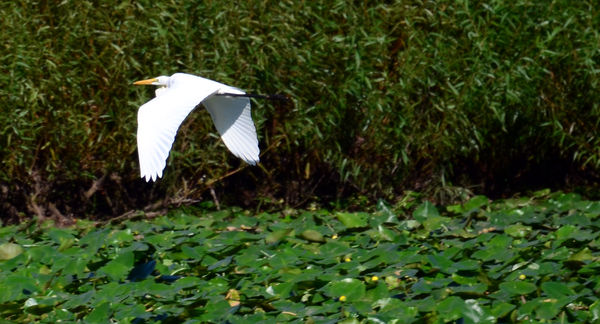Circular Polarizer Filter
Sep 16, 2012 18:23:21 #
Would a circular polarizer filter help to keep the white on the egret from being blown out. Sun was behind me about 10:00am ISO200 Shutter priority 1/1000 300 mm 5.6. If not, what is solution?

Sep 16, 2012 20:24:08 #
rrayr2002 wrote:
Would a circular polarizer filter help to keep the white on the egret from being blown out. Sun was behind me about 10:00am ISO200 Shutter priority 1/1000 300 mm 5.6. If not, what is solution?
How did you meter the exposure? Try spot metering the bird next time if you hadn't. 8-)
Sep 16, 2012 20:24:29 #
The light from the egret is not polarized, therefore a polarizer will not differentially reduce the egret's reflected light when compared to the background. The polarizer will simply act like an ND filter and reduce your overall exposure. Light reflected off of items such as water, glass, chrome, etc., is polarized and therefore rotating a CP filter will reduce the polarized light coming from the item but will leave the surrounding light and exposure unaffected.
As far as what you can do about this type of shot, my two cents would be that there is too much contrast between your egret and the background for your equipment to adequately capture. It is exposing for the overall scene and can't handle the bright white. Therefore, I would look for an area without the dense, dark foliage as a background. My second thought is that you might be better off if you used a spotmeter setting and meter off the egret. This will result in a slight underexposure, but can be easily corrected in post processing. If you can't do either, try bracketing or test out a one or two stop underexposure compensation.
As far as what you can do about this type of shot, my two cents would be that there is too much contrast between your egret and the background for your equipment to adequately capture. It is exposing for the overall scene and can't handle the bright white. Therefore, I would look for an area without the dense, dark foliage as a background. My second thought is that you might be better off if you used a spotmeter setting and meter off the egret. This will result in a slight underexposure, but can be easily corrected in post processing. If you can't do either, try bracketing or test out a one or two stop underexposure compensation.
Sep 16, 2012 20:42:40 #
unclebe1 wrote:
The light from the egret is not polarized, therefo... (show quote)
mid-sunny day is the hardest time for shooting light objects. On a cloudy day or early/ late gives better results. On this one, which is great composition, I would have shot faster which would have darkened the background and shadow areas but if lucky would have brought out more definition on the egret, or look for a shaded spot to shoot into.
Sep 16, 2012 23:53:32 #
Also, for a CP to work properly, the sun should be at 90 degrees to the line of sight, not right behind you.
Sep 17, 2012 08:55:14 #
Meter spot on the bird, only if you have asked the bird to cooperate! Ain't goina happen. Recently I photographed a small heard of about 25 white feathered small Raptor Dinosaurs (White Ibis) in a prehistoric Florida lake (50' in diameter 4" deep)and from experience I simply went negative with the exposure setting... -1, & -2 wa la good exposure on the white feathered beasts.
Ray, keep life simple, screw sophistication, embrace elegant solutions of simplicity based on knowledge of light and the camera, and composition principles and stick with practicability. Get a pocket size P&S and glue it to your hip.... always with you with a fresh battery in reserve. Take lots of shots, hi,low, left, right,,, digital film comes as 1200 in a roll not 12, 24, 36.
Study the physics of light, the fine points of edit and resizing up with algorithms and realize that DSLR are only there for show, eventually on their way out.. Pros using I-phones are now exhibiting and accessories are available. If I had relied on my DSLR I would have had to go home and get it... decide on what lenses to take, which filters to attach, etc... as it was when this herd of white dino birds presented them selves, I had my Panasonic TZ3 in my belt pack and was ready to be spontaneous.
Now if you have an I-Phone you do not even need a separate camera.. just an old Marlboro Cigarette box pack filled with various lenses and filters that latch on with a Velcro ring and you are a pro. As Bob Dilan would say.. Get out the door way, the times are a changen... so it is with technology.
Have fun....
Ray, keep life simple, screw sophistication, embrace elegant solutions of simplicity based on knowledge of light and the camera, and composition principles and stick with practicability. Get a pocket size P&S and glue it to your hip.... always with you with a fresh battery in reserve. Take lots of shots, hi,low, left, right,,, digital film comes as 1200 in a roll not 12, 24, 36.
Study the physics of light, the fine points of edit and resizing up with algorithms and realize that DSLR are only there for show, eventually on their way out.. Pros using I-phones are now exhibiting and accessories are available. If I had relied on my DSLR I would have had to go home and get it... decide on what lenses to take, which filters to attach, etc... as it was when this herd of white dino birds presented them selves, I had my Panasonic TZ3 in my belt pack and was ready to be spontaneous.
Now if you have an I-Phone you do not even need a separate camera.. just an old Marlboro Cigarette box pack filled with various lenses and filters that latch on with a Velcro ring and you are a pro. As Bob Dilan would say.. Get out the door way, the times are a changen... so it is with technology.
Have fun....
Sep 17, 2012 13:16:46 #
I failed to mention that this bird was 180 yards out. Checked it with rangefinder. That is kind of a stretch for my sony or nikon P&S cameras. But a good idea.
Sep 17, 2012 13:36:34 #
Mogul wrote:
Also, for a CP to work properly, the sun should be at 90 degrees to the line of sight, not right behind you.
That's the case for when you want to use a CP to darken the sky. If you use the CP to reduce glare, then the position of the sun is unimportant. Under some atmospheric conditions, sunlight is partially polarized as it passes through the atmosphere. On those occassions, using a CP and keeping the sun to your left or right will allow you to darken the sky without darkening the rest of your shot. However, the effect is not necessarily uniform across the sky, so take a few shots with different CP rotations to determine if the effect is a keeper or not.
Sep 17, 2012 22:45:07 #
Well, in this case, the CPF would do no good darkening the sky... why... eraaaa, no sky. Again in this case reduce the ev and the feathers will appear in more detail.
If you want to reply, then register here. Registration is free and your account is created instantly, so you can post right away.



